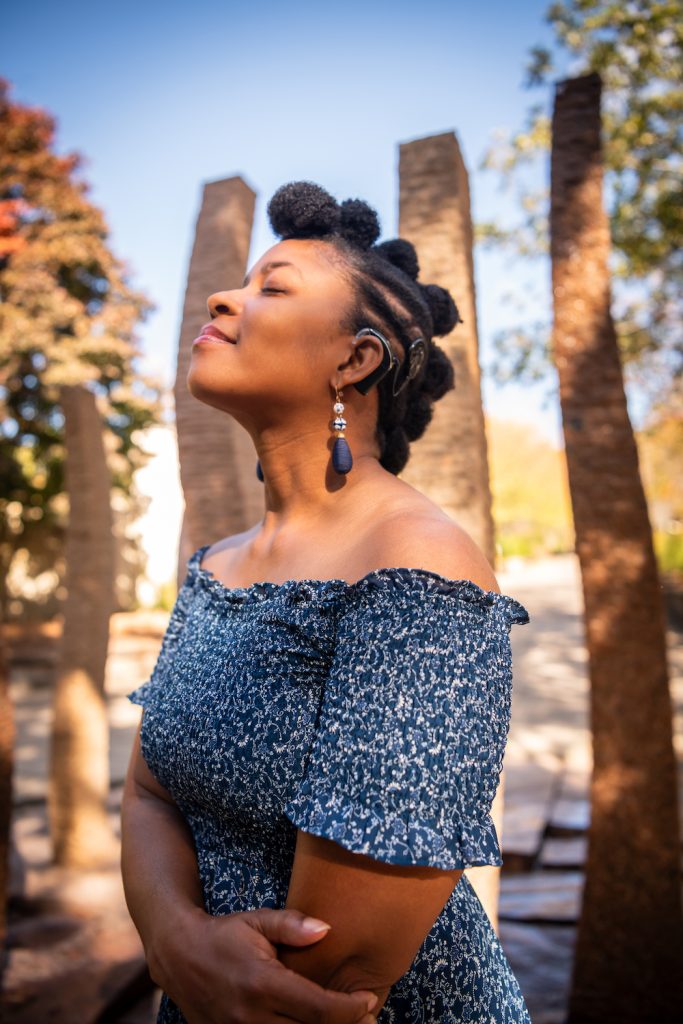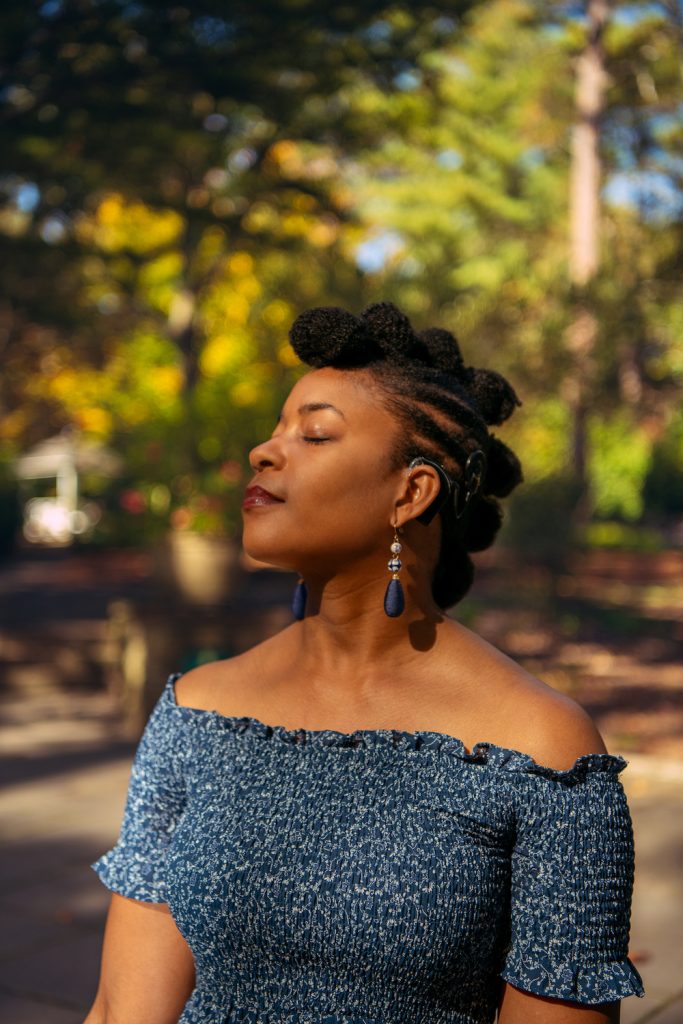
By Je’Don Holloway-Talley
For The Birmingham Times
Nicole LaMont was like any typical adolescent—fully functioning limbs, faculties, and all five senses. That changed for her at age 12.
“It was roughly 3 a.m. when I woke up deaf. Kind of like when someone suddenly turns the TV off when you’re sleeping, so the sudden silence wakes you up, … the silence jolted me,” LaMont recalled. “I first made some clicking sounds with my tongue and couldn’t hear it, so then I knocked on my nightstand and couldn’t hear that either.
“Then I thought perhaps I was dreaming and contemplated trying to go back to sleep and waking up for real—or running screaming to my mom. … Oddly, I wasn’t immediately panicked. I was more confused. I didn’t understand why it was so quiet.”
Doctors did not initially believe LaMont’s claim of deafness. She vividly remembers the trip to the emergency room and the worry etched on her mother’s face. “I saw multiple doctors and had tests done,” she said.
Eight months later and after dozens of tests, the cause behind LaMont’s sudden hearing loss was diagnosed. She had developed a rare autoimmune condition called neurosarcoidosis, which causes inflammation and abnormal cell deposits in any part of the nervous system: the brain, spinal cord, muscles, or peripheral nerves. LaMont’s bout with the condition resulted in bilateral deafness, meaning she was permanently deaf in both ears.
LaMont is a medical laboratory scientist for the Birmingham Veterans Affairs (VA) Medical Center, where she is responsible for performing scientific testing on samples in areas like microbiology, hematology, and urinalysis, as well as for reporting results to physicians. She also has an impressive social media following, with more than 65,000 followers on Instagram, 79,000 on Facebook, and growing audiences on YouTube and TikTok.
“I am still astonished by my following. The most popular videos that seem to get the most views are [the ones teaching] medical signs,” said LaMont, who answered her interview questions for this story via email.
“There are so many nurses and doctors who want to be able to have open communication with their patients,” she explained. “[As a member of the deaf community], it is such a relief when we see our nurses and providers attempting to make our visits less stressful and more inclusive.”
After being asked to teach American Sign Language (ASL) for many years, LaMont decided in October 2022 to post some fun, basic ASL videos on Facebook Instagram, and YouTube for family and friends. “Shortly thereafter, it took off and led me to the following and platform I have now,” she said.
Best of Both Worlds
At age 13, when LaMont learned that she wouldn’t regain her hearing, she had a procedure to get a cochlear implant (CI), which is a surgically implanted neuroprosthesis, or a device that is meant to replace missing biological functionality that might have been damaged as a result of an injury or a disease. It provides a person who has moderate to profound sensorineural hearing loss with sound perception.
“Without CIs, I am profoundly deaf and without any recognition of sound. With my CIs, while I am still considered profoundly deaf, they give me the ability to hear sound in the way I remember sound to be prior to my deafness. I do still miss some words here and there, but I have the best of both worlds,” she said.
Initially, LaMont rejected ASL. Her family tried to teach her at home, as well as encourage her to take classes at Auburn University Montgomery (AUM) and the Vocational Rehabilitation Service Blind and Deaf Division, which is made available through the Alabama Department of Rehabilitation Services (ADRS). Everyone in LaMont’s family took classes—except her.
“I was embarrassed to sign in public,” she said. “I was getting bullied in school. My so-called friends were now mocking me and would throw up fake sign language in my face to tease me.”
To make matters worse, LaMont was also humiliated before a classroom of her peers by her own teacher.
“I had always completed my work early and would doodle and draw while sitting in silence because I was deaf and had no interpreter, and [the teacher] got mad at me for looking down at my notebook. … He complimented my drawing skills and then made me go stand in front of the class.
“[When I got to the front], he covered his mouth with his hand, so I couldn’t read his lips, and said something. Then he uncovered [his mouth] and told me to repeat to the class what he just said. I just stood there mortified, and then I burst into tears. … This was just a few months after I had woken up deaf,” LaMont remembered.
Importance of Representation
Instances such as those taught LaMont the importance of representation and advocacy for those with special needs. She doesn’t remember many positive hearing-impaired role models during her adolescent years, which can be a crucial time for preteens and their sense of identity.
She does, however, recall the impact of Disney’s “The Little Mermaid” series and a three-part episode titled “Wish Upon a Starfish,” during which Ariel, the mermaid and main character in the franchise, meets what LaMont perceived as “a Black mermaid at the time, but she was really Latina. … Her name was Gabriella, she had a purple fin, my favorite color, and she was deaf. She used very accurate ASL in the cartoon, and that was my first time seeing a deaf person, let alone [a deaf] person of color portrayed on TV.”
Eventually, LaMont saw that deaf wasn’t a bad word. She embraced ASL and became fluent in less than four weeks after taking classes at Gallaudet University (GU), a private federally chartered university in Washington, D.C., for the education of the deaf and hard of hearing.
She earned a Bachelor of Science degree in biology, from GU in 2008, a Bachelor of Science degree in medical laboratory science from AUM in 2016, and a Master of Science degree in clinical pathology from the University of Alabama at Birmingham (UAB) in 2020.
During her collegiate years, the Montgomery, Alabama, native would become Miss Deaf Alabama (2009–2011), Miss Black Deaf D.C., and Miss Black Deaf Student Union.
“My platform was to bridge the gap between the deaf and hearing communities,” said LaMont. “[Using my platform], I advocated for accessibility to entertainment and for other public settings to have open [captioning, which are permanently visible on the screen], and closed captioning, [which can be turned off], in movie theaters, waiting rooms. … I also encourage hearing parents of deaf children to strive for open communication for their children using ASL, in addition to whatever hearing devices the family feels fit their child’s needs.”
“Hearing devices are wonderful, but they are technology and man-made,” she added. “ASL is always going to be there and won’t fail. It won’t run out of batteries and does not depend on external energy other than the physical.”
Science and Medicine
LaMont always seemed destined to become a laboratory scientist. The Birmingham resident has a twin sister, Monique, and an older brother, Mikal.
“My older brother was always mixing potions and really into science. He had his own little microscope and everything, and I followed everything he did,” said LaMont. “I’m one of the very few people who can look back at her 5-year-old diary and see that a dream became reality. In my earliest writing, I wrote, ‘I’m going to be a scientist.’ I was naturally drawn to shows like ‘ER’ or anything that had to do with medicine.”
Science and medicine run in the family. LaMont’s mother is a retired psychiatric nurse practitioner, and her twin sister followed in their mother’s footsteps and is a psychiatric nurse practitioner who also has served in the U.S. Air Force. Her maternal uncle is a retired nurse anesthetist, her grandmother is a retired registered nurse, and her cousins on her dad’s side are in the medical field.
“I’ve always been surrounded by those who study medicine,” she said.
In addition to being surrounded with science and medical experts, LaMont was influenced by a law enforcement professional. Her father is a retired controls worker, who operated and maintained the security and integrity at a detention center via the security system located at the central control facility. At retirement, he was a control worker for the juvenile courts in Montgomery.
“That’s why we were such good kids,” she joked.
You can learn more about Nicole LaMont via social media on Instagram (@signingwithnicole) Facebook: (https://www.facebook.com/nictwin1), YouTube (@ndlamont01) and TikTok (@nictwin1).
























